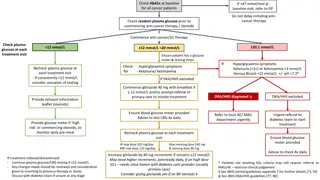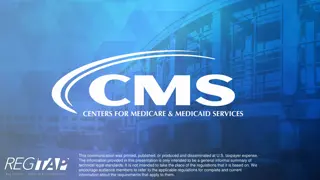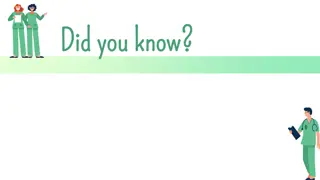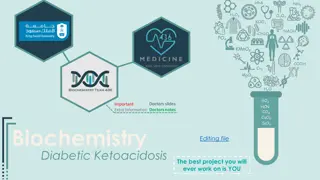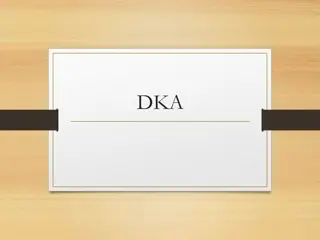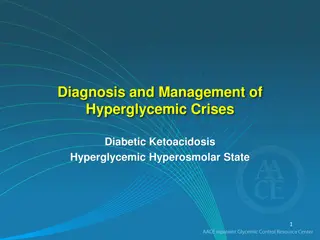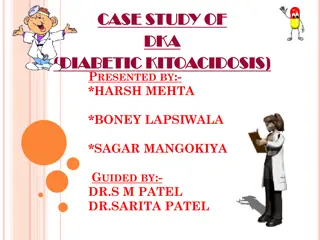Hypoglycaemia, DKA and HHS RECOGNITION, PREVENTION, TREATMENT
Hypoglycaemia is characterized by low blood glucose levels and is common in individuals with Type 1 or Type 2 diabetes on insulin or sulphonylureas. Recognizing risk factors, clinical features, and causes is crucial for timely intervention. Treatment involves quick-acting carbohydrates to normalize glucose levels. This comprehensive guide covers identification, prevention, and management strategies for hypoglycaemia.
Download Presentation

Please find below an Image/Link to download the presentation.
The content on the website is provided AS IS for your information and personal use only. It may not be sold, licensed, or shared on other websites without obtaining consent from the author. Download presentation by click this link. If you encounter any issues during the download, it is possible that the publisher has removed the file from their server.
E N D
Presentation Transcript
Hypoglycaemia, DKA and HHS RECOGNITION, PREVENTION, TREATMENT
What is Hypoglycaemia? Blood glucose below 4mmol/l Common in people with Type 1 Diabetes and in people with Type 2 when treated with insulin or sulphonylureas (eg: Gliclazide) More common in Type 2 in elderly and those with renal impairment Consider Hypoglycaemia in person with diabetes who is unwell, drowsy, uncooperative, aggressive or having seizures
Risk Factors Strict glycaemic control Impaired awareness Previous severe hypoglycaemia Inadequate treatment of previous hypoglycaemia Increasing age Cognitive impairment/Dementia No or inadequate blood glucose monitoring Reduced carbohydrate intake for any reason Impaired renal function Lipohypertrophy
Clinical features Sweating Light-headedness Trembling / shaking Hunger Anxiety Palpitations Irritability Drowsiness Poor Communication Slurred speech Confusion Poor co-ordination Aggressive behaviour Loss of consciousness The symptoms of hypoglycaemia vary considerably between individuals and this list is not exhaustive. Impaired awareness is associated with higher risk of severe hypoglycaemia.
Causes Potential causes of hypoglycaemia: Mismatch between insulin given and food eaten Less carbohydrate than normal with meals Failure to monitor blood glucose adequately Vomiting Inappropriately timed insulin or OHA in relation to meal or enteral feed Stopping or reducing steroids Reduced appetite Missed or delayed meals
TREATMENT OF HYPOGLYCAEMIA Hypoglycaemia is a blood glucose of 4 mmol/L or less Wherever possible, check blood glucose level prior to treatment. If patient asymptomatic, repeat test
Treatment Once hypoglycaemia is identified, the patient should be treated without delay Quick-acting carbohydrate required to return glucose level to normal Follow up with more complex carbohydrate snack or meal if due Treatment options will depend on whether patient can swallow, is drowsy/confused or unconscious
Prevention Consider what caused the Hypo Is a medical review required? Medications should be reviewed and adjusted if necessary Is patient education required? Remember that risk of further hypo is higher in following 24 hours
Hyperglycaemia Excess glucose in the blood (over 12mmol/L) - If persistent can cause unpleasant symptoms and long-term consequences Many possible causes Possible life-threatening complications: - Diabetic Ketoacidosis (DKA) - Hyperosmolar Hyperglycaemic State (HHS)
Possible causes Illness (eg: infection) Dietary factors Sugary drinks, extra snacking, large amount of carbohydrate Stress Insufficient treatment Certain medications (eg: steroids) Injection site issues Problems with insulin (eg: inappropriate storage)
Signs and symptoms Thirst, dry mouth Tiredness Blurred vision Increased urine output - Consider hyperglycaemia in patients with urinary incontinence - Increased risk of UTI Poorly healing wounds
Hyperglycaemia in the Community Target blood glucose for elderly people usually higher around 6- 12mmol/L, but will be specific to the individual Higher target to reduce risk of Hypoglycaemia Important to avoid prolonged high blood glucose levels due to the risk of HHS and DKA High blood glucose causes unpleasant symptoms and should not be ignored
What next? Consider the cause of high blood glucose - Can this be avoided in future? Is a review of medication required? Is a medical review required?
Not to be ignored If the patient is unwell and you are concerned, seek medical advice - Inability to swallow/not able to keep fluids down - Vomiting - Persistent Diarrhoea - Persistently high glucose - Underlying infection Raised ketone level Symptoms of ketoacidosis - -
DKA High BG levels Osmotic symptoms Dry/flushed skin Tired Hard to breathe Abdominal pain Feeling sick or being sick Smell on breath ( ketones) Large ketones in blood/urine
Who is at risk? Young children symptoms often similar to childhood illnesses Pregnant women high ketones can affect the unborn baby Pump users no background insulin if pump fails Adolescents body image,chaotic lifestyle,substance abuse,emotions,growth hormones The elderly
Hyperosmolar hyperglycaemic syndrome(HHS) Hypovolaemia Marked hyperglycaemia (>30 mmol/L) without significant ketonuria or acidosis (pH>7.3, bicarbonate >15 mmol/L) Osmolality >320 mosmol/kg
Who is at risk? Type 2 diabetes Over 65 years old Chronic health condition ie: heart/kidney disease Illness/Infection Steroids, diuretics
HHS Goals of Treatment Treat the underlying cause gradually and safely Normalise osmolality Replace fluid and electrolyte losses Normalise blood glucose Prevent arterial or venous thrombosis Prevent other potential complications e.g. cerebral oedema/ central pontine myelinolysis Prevent foot ulceration
Main Points Anyone involved in the care of a person with diabetes should be aware of these potential emergencies Know the signs and symptoms Understand your patient s risk factors and reduce these where possible Know what action is required and treat appropriately Seek medical assistance without delay when necessary






